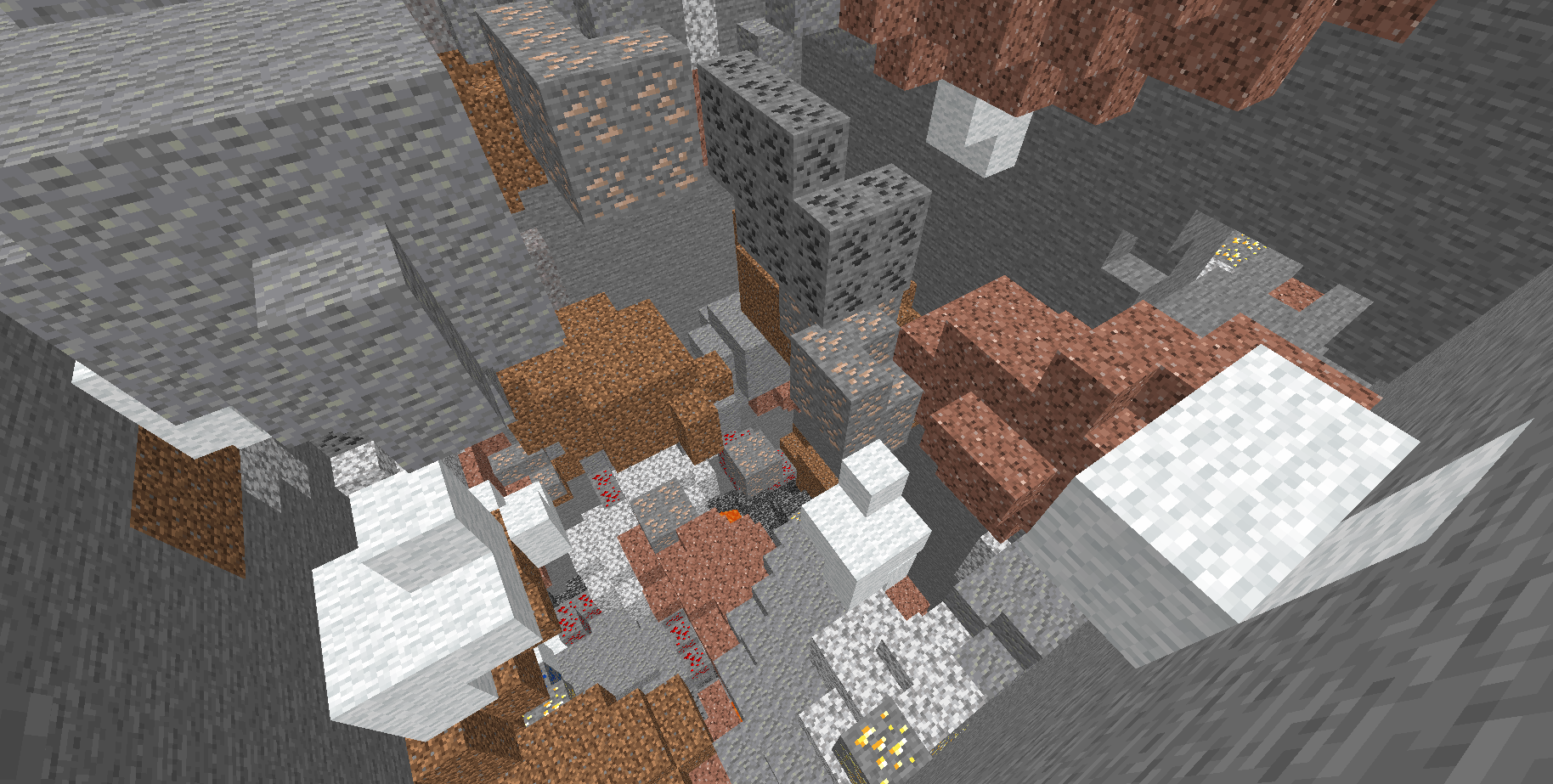This is an old revision of the document!
Table of Contents
Generating Custom Ores [1.18.2]
A lot of mods add their own ores, and you'll need a way to place them in existing biomes for players to find. In this tutorial, we'll look at adding ores to existing biomes. There are 2 steps that are required to add ores to biomes.
- Make a ConfiguredFeature. This defines how your ore block is spawned.
- Use Biome Modification API in Fabric API to add your feature to biomes.
Note that the Biome Modification API is marked as experimental. If the API doesn't work, consider using the mixin version.
We'll assume you've already created your own ore block at this point. Wool block will serve as our replacement throughout this tutorial. Replace references to wool with your ore when appropriate.
Adding to the overworld biomes
In this section, our goal will be spawning the ore in the overworld.
We need to create a ConfiguredFeature.
Make sure to register your ConfiguredFeature at onInitialize.
Feel free to change the values to suit your mod.
public class ExampleMod implements ModInitializer { private static ConfiguredFeature<?, ?> OVERWORLD_WOOL_ORE_CONFIGURED_FEATURE = new ConfiguredFeature (Feature.ORE, new OreFeatureConfig( OreConfiguredFeatures.STONE_ORE_REPLACEABLES, Blocks.WHITE_WOOL.getDefaultState(), 9)); // vein size public static PlacedFeature OVERWORLD_WOOL_ORE_PLACED_FEATURE = new PlacedFeature( RegistryEntry.of(OVERWORLD_WOOL_ORE_CONFIGURED_FEATURE), Arrays.asList( CountPlacementModifier.of(20), // number of veins per chunk SquarePlacementModifier.of(), // spreading horizontally HeightRangePlacementModifier.uniform(YOffset.getBottom(), YOffset.fixed(64)) )); // height @Override public void onInitialize() { Registry.register(BuiltinRegistries.CONFIGURED_FEATURE, new Identifier("tutorial", "overworld_wool_ore"), OVERWORLD_WOOL_ORE_CONFIGURED_FEATURE); Registry.register(BuiltinRegistries.PLACED_FEATURE, new Identifier("tutorial", "overworld_wool_ore"), OVERWORLD_WOOL_ORE_PLACED_FEATURE); BiomeModifications.addFeature(BiomeSelectors.foundInOverworld(), GenerationStep.Feature.UNDERGROUND_ORES, RegistryKey.of(Registry.PLACED_FEATURE_KEY, new Identifier("tutorial", "overworld_wool_ore"))); } }
Result
Always create a new world when you check the world generation result. You should see wool spawning in the overworld. You can use the command below to remove stone blocks surrounding you.
/fill ~-8 0 ~-8 ~8 ~ ~8 minecraft:air replace minecraft:stone
Adding to the nether biomes
In this section, based on the code in the previous section, we will add the ore to the nether biomes.
We need to replace OreConfiguredFeatures.STONE_ORE_REPLACEABLES with OreConfiguredFeatures.NETHERRACK
because the ore has to replace different blocks in the nether than in the overworld.
public class ExampleMod implements ModInitializer { private static ConfiguredFeature<?, ?> NETHER_WOOL_ORE_CONFIGURED_FEATURE = Feature.ORE .configure(new OreFeatureConfig( OreConfiguredFeatures.NETHERRACK, // we use OreConfiguredFeatures.NETHERRACK here Blocks.WHITE_WOOL.getDefaultState(), 9)); public static PlacedFeature NETHER_WOOL_ORE_PLACED_FEATURE = NETHER_WOOL_ORE_CONFIGURED_FEATURE.withPlacement( CountPlacementModifier.of(20), SquarePlacementModifier.of(), HeightRangePlacementModifier.uniform(YOffset.getBottom(), YOffset.fixed(64))); @Override public void onInitialize() { Registry.register(BuiltinRegistries.CONFIGURED_FEATURE, new Identifier("tutorial", "nether_wool_ore"), NETHER_WOOL_ORE_CONFIGURED_FEATURE); Registry.register(BuiltinRegistries.PLACED_FEATURE, new Identifier("tutorial", "nether_wool_ore"), NETHER_WOOL_ORE_PLACED_FEATURE); BiomeModifications.addFeature(BiomeSelectors.foundInTheNether(), GenerationStep.Feature.UNDERGROUND_ORES, RegistryKey.of(Registry.PLACED_FEATURE_KEY, new Identifier("tutorial", "nether_wool_ore"))); } }
Adding to the end biomes
In this section, based on the code in the overworld section, we will add the ore to the end biomes.
We replace OreConfiguredFeatures.STONE_ORE_REPLACEABLES with new BlockMatchRuleTest(Blocks.END_STONE).
public class ExampleMod implements ModInitializer { private static ConfiguredFeature<?, ?> END_WOOL_ORE_CONFIGURED_FEATURE = Feature.ORE .configure(new OreFeatureConfig( new BlockMatchRuleTest(Blocks.END_STONE), // we use new BlockMatchRuleTest(Blocks.END_STONE) here Blocks.WHITE_WOOL.getDefaultState(), 9)); public static PlacedFeature END_WOOL_ORE_PLACED_FEATURE = END_WOOL_ORE_CONFIGURED_FEATURE.withPlacement( CountPlacementModifier.of(20), SquarePlacementModifier.of(), HeightRangePlacementModifier.uniform(YOffset.getBottom(), YOffset.fixed(64))); @Override public void onInitialize() { Registry.register(BuiltinRegistries.CONFIGURED_FEATURE, new Identifier("tutorial", "end_wool_ore"), END_WOOL_ORE_CONFIGURED_FEATURE); Registry.register(BuiltinRegistries.PLACED_FEATURE, new Identifier("tutorial", "end_wool_ore"), END_WOOL_ORE_PLACED_FEATURE); BiomeModifications.addFeature(BiomeSelectors.foundInTheEnd(), GenerationStep.Feature.UNDERGROUND_ORES, RegistryKey.of(Registry.PLACED_FEATURE_KEY, new Identifier("tutorial", "end_wool_ore"))); } }

